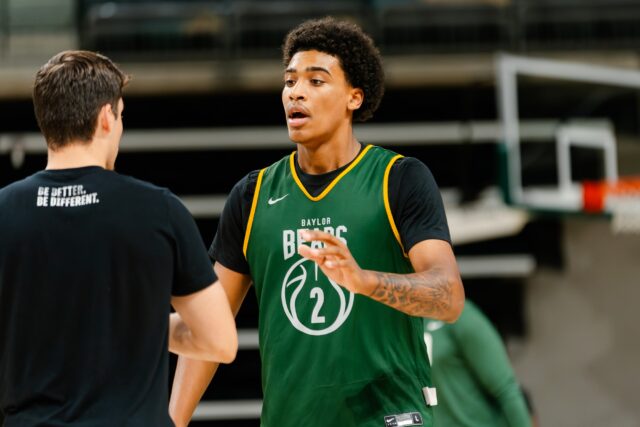Dylan Fink | Sports Writer
For the fifth straight season, Baylor men’s basketball has lost a player to an ACL tear.
Freshman forward Maikcol Perez tore his ACL in practice and will miss the entirety of the 2025-26 season, head coach Scott Drew confirmed last week. Former Bears Josh Ojianwuna (2025), Yanis Ndjonga (2023), Jonathan Tchamwa Tchatchoua (2022) and Langston Love (2021) all suffered the same injury as Perez during their careers in Waco.
“In basketball, you’re going to have injuries,” Drew said. “You pray they’re not long-term, but unfortunately Perez’s is.”
Drew’s first 17 years in Waco saw just one season-ending ACL injury. The past five years have seen five.
The rise in severe ligament injuries in recent years is a growing concern not just for the Bears but for all of the basketball world. The NBA saw seven Achilles tendon tears this season alone — a dramatic increase from the league’s average of 1.36 Achilles-related injuries per season from 1990 to 2023.
“We had seven this year. We had zero last year under the exact same circumstances,” NBA commissioner Adam Silver told ESPN. “The most we’ve ever had in a season is four.”
Drew pointed to specialization in youth sports as a potential contributing factor to the rapid increase in ligament injuries across the nation.
“Players are so sport-specific at such a young age,” Drew said. “Back in the day, players used to play three or four sports. You didn’t train hard year-round.”
At the highest levels, modern prep basketball features both a high-intensity high school season and a travel-heavy AAU circuit, neither of which allows for extended breaks between time played. The demand for year-round play from young athletes puts unexpected wear on the human body that it isn’t necessarily built to endure.
“Look at the amount of load that the athletes are putting on their body and the amount of recovery,” said Dr. Michael Fredericson, director of physical medicine and rehabilitation for sports at Stanford, in a June 2025 interview with ESPN. “If you’re looking at a calf muscle, or the ligaments and tendons of the average 22-year-old player, they’ve already had so much mileage on them compared to players 30 or 40 years ago who weren’t doing that.”
While overuse between the regular season and nonstop AAU circuits puts more stress on young athletes’ bodies, basketball professionals are attempting to find a way to preserve athletes’ physicality without reducing the amount of basketball being played.
Former NBA champion Channing Frye credited the uptick of injuries not to too many games, but rather to overuse in practice for young players.
“I’m a practice guy, but not an all-the-time practice guy,” Frye said on his podcast, Road Trippin’. “If you hear the stories of the old-school guys like [Michael] Jordan and [Charles] Barkley, they only practiced when they needed to practice because they knew they couldn’t do that every day.”
Frye’s former teammate Richard Jefferson agreed.
“It’s mostly load management,” Jefferson said. “The high-usage [players] are making explosive movements more often than everyone else, and eventually that can lead to these injuries.”
Drew is aware of the wear and tear that the modern path to Division I basketball can put on a young athlete’s body, but he also acknowledged that there is currently no single solution to reverse the trend.
“There’s not something that you can say, ‘This is how it is, this is how we correct it,’” Drew said. “It’s kind of like a roulette wheel. Sometimes it’s black, black, black, and sometimes it’s red, red, red. We’re definitely on a bad streak right here, going five-for-five.”
Following the Achilles tears of NBA stars Jayson Tatum, Damian Lillard and Tyrese Haliburton in the 2025 postseason, the league assembled a group of experts to investigate possible changes to reduce the number of soft-tissue injuries. The NBA plans to share its findings with the rest of the basketball world as the rise in ligament injuries affects the sport at all levels of the game.
The competitive drive of today’s players affects their mentality differently than that of coaches and executives. Following his Achilles tear in June, Haliburton quoted former five-time NBA champion Kobe Bryant, who tore his Achilles in 2013.
“I think Kobe said it best when in this same situation,” Haliburton wrote. “There are far greater issues/challenges in the world than a torn Achilles. Stop feeling sorry for yourself, find the silver lining and get to work with the same belief, same drive and same conviction as ever.”
Baylor will host an open exhibition game against Grand Canyon at 4 p.m. Oct. 10 at Foster Pavilion. The Bears will host UTRGV for their season opener on Nov. 3.


